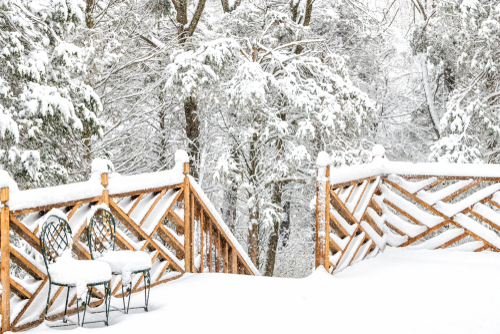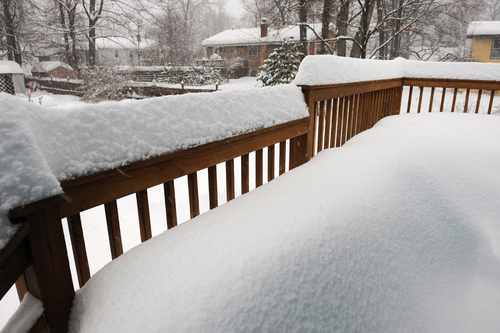To keep your deck in good condition during the winter you have to shove off the snow regularly, apply the stain, remove the traps, and de-ice the deck.
During winter, there will be frost and snow. The snowfall and frost on your deck can create some serious issues.
Because of the water content in them, the deck will be soggy and wet it will become slippery and difficult to use. But there are ways to resolve this problem. Following some easy steps, you can protect your deck and keep it in top condition so when the winter ends, it will still be strong and sturdy.
To protect your deck from the damaging condition of winter, maintain the following tips.
1. Check for Damages
There might be cracks and damages caused by seasonal changes, and to avoid it regular monitoring is necessary. Timber is vulnerable to dry rots as they create splits and holes in the wood. Use fillers such as Cetol Gupa from Sikken to fill those cracks and holes.
They dry very fast and can be a very good stopper for holes. Repairing should be done before recoating because that will prevent any further damage to the wood and make it more resilient.
2. Protect It by Applying Stain
This step is more of a precaution and should be taken long before the arrival of winter. By applying stain, or even paint, you will be able to protect your deck from the harsh cold winter.
If the weather gets dry and cold, the deck might crack and split. Stain and paint can help prevent your deck planks from cracking up and damaging the whole structure. You can use oil-based or water-based stains to turn it into the prettiest deck even during the winter.
Stains also come in different finishes. Some have matte finishes and some even have UV-resistant features.
3. Clean the Deck Properly

To ensure that the deck remains dry most of the time, you need to clean it and shove off all the snow from your deck. Use a scrub or a dry cloth to clean it if there are a lot of dew particles.
Make sure that there is no mold growing as these can make the deck very slippery. Check the gaps between the planks to see if any mold is growing and remove these immediately when you spot them.
But before you clean the whole deck, you also need to find the perfect cleaner that works best for your deck.
A blend of hydrogen peroxide and soda ash should create a nice blend of oxygen bleach. You can use water and oxygen bleach to get rid of any kind of mold on your deck.
4. Recoat Before Winter
Clean the deck surface before applying any coating. The debris might prevent the coating from penetrating the timber and providing longer protection.
Cetol BL Deck & Wood Cleaners from Sikken are the best cleaner for hardwood decks. To clean the deck, first, wet the deck. Then, apply the cleaner and mop the whole deck. Use a bristle brush to ensure that the cleaner penetrates the wood and leave it for 15 minutes.
If you see the wood drying up, spray water over the dried parts. Finally, wash the whole deck with a high-pressure hose and let the deck dry. Wait for three days and then you can apply any coating of your choice.
5. Water Repellent Seals Offer Great Protection
A high tier water repellent seal will work wonders and provide excellent protection against the cold, snow, and dew of the winter season. They will cover up the deck, fill any cracks, and can protect the wood against ice.
Although applying these repellents requires you to remove the previous coating or finishes, it is worth the investment as they protect the deck from getting damaged.
6. Prevent Slippery Decks
As mentioned earlier, the frost and snow can make your deck slippery. This slippery platform is also a perfect place for moss and mold to grow. This not only damages the deck but also can cause health hazards and injuries.
To protect it from getting slippery, you can apply sand all over the deck. After a heavy snowfall, you have to use sand as it increases the traction of the deck and prevents you from slipping.
7. Use Tarp
If all of this is a huge hassle and you do not feel like doing it at all, or the winter this season will not be very strong then you can always use a tarp. Tarps will act as a barrier that will shield the deck from the cold weather.
But be warned, the colder the weather gets, the less effective tarps become. Most traps will not even work during harsh winters.
Even if you apply stains or sealants, your deck is still vulnerable to the cold of the winter. To prevent the snow or ice from getting in contact with the deck, apply a tarp barrier over the whole deck.
Tarps protect the deck from ice, snow, dew, and even hail. Be sure to remove the snow piling up on top of the tarp as they melt, otherwise, it will damage the boards of the deck.
8. Easily Remove the Debris
So even after cleaning the whole deck, there might still be some debris left. Dry leaves, acorns, pine cones are common debris in winter and need to be cleaned regularly, to make sure your deck is in good condition.
Not doing so might put scratch marks in your deck, and if they get stuck in between gaps of the plank, they might also cause dents and damage the deck.
If the debris is very light, you might use a leaf blower instead of any expensive cleaner. Leaving debris for a long time will cause the color to fade and make your deck appear dirty and old.
9. Remove the Snow

Yes, the biggest problem of winter, heavy snow. When snow falls on your deck, it can create big problems.
It can dry up your deck, causing it to crack and split if the snow is heavy, then the cold water from the melted snow can cause the wood of your deck to shrink. Just like cleaning the garden, you have to clean the deck whenever you get snow during the winter.
Later when that snow melts, the deck will absorb the water and the decks will try to expand again, thus making the planks unstable and also vulnerable to breaking apart. So, when it becomes possible to go outside, use a shovel and clean the snow before it melts.
You have to be careful while removing the piled-up snow from your deck. Be sure not to use metal shovels or any sharp and heavy tools. These tools can put scratch marks and crack in your wood and do more damage.
Plastic snow shovels can be an excellent alternative that has no risk but does the same work. Shove the shovel by running it in a parallel manner to the wood grain. This ensures that there is no room for scratches.
If there is very light snow, you can use leaf blowers to remove them.
10. De-icing the Deck
If you are unable to shovel away all of the ice, some part of the deck might become frozen. But fret not, because there is a solution for that as well.
Various popular de-icing components help melt the ice from your deck. If your deck is not made of wood, try using Rock Salt and similar deicing compounds that can easily melt the ice.
However, if your deck is made of wood, it is better to leave them be and let the ice melt by itself.
Rock salt can cause stains on a wooden deck. Be careful while selecting the compound as rough compounds can damage the surface of the deck.
11. Remove the Ice Melt Compounds
Contrary to popular belief, Rock Salt is not one hundred percent beneficial for your deck. So, even though it is very popular, it is best to remove them as soon as the ice melts and not leave them on your deck for a long time.
Rock salts have a high absorbing nature, so after it drains all the ice, it will also start to drain the natural moisture of the wooden deck and damage it. So, removing them soon will keep your deck fresh and sturdy.
12. Remove Overhead Branches
If there are tree branches on top of your deck, it’s better to remove them as soon as possible.
Although branches that are stable enough to withstand the heavy snow do not possess any danger, it is better to remove them, especially if the branches appear weak or dead.
Larger branches can damage your deck so it’s better to remove them altogether.
Final Thought
The deck in your house needs special care during winter to ensure that it holds the natural glow and beauty it had during the summer. Hopefully, following these steps will keep your deck clean, and in top shape for the spring that is about to come.







































































This is so great! Thanks for sharing! While I love having our deck, making sure it stays in good condition, especially during the wintertime sucks. I will definitely be taking your deck maintenancetips and using them to try to keep our deck in better condition during the winter. Thanks for sharing!